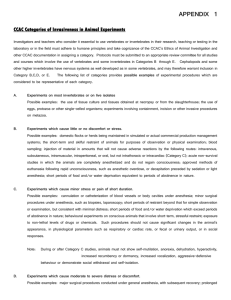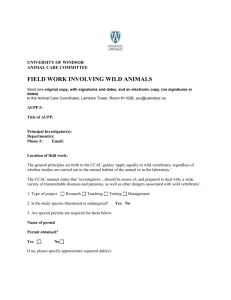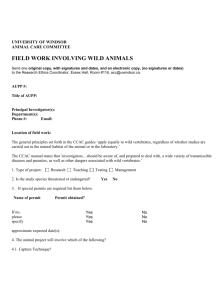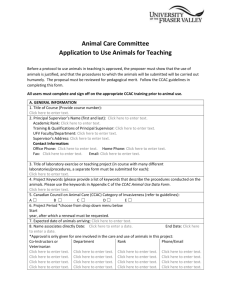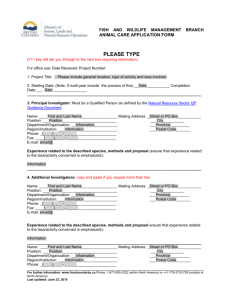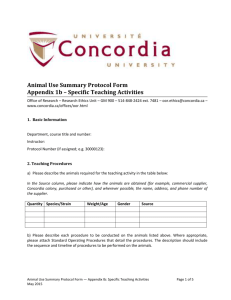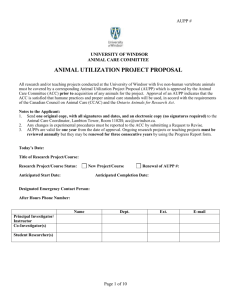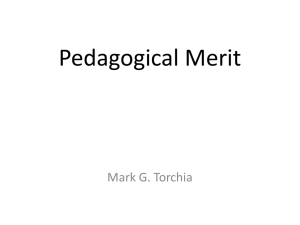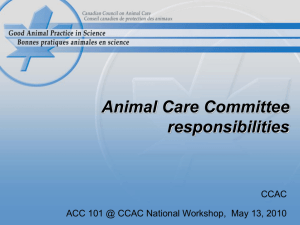Instruction Guide
advertisement
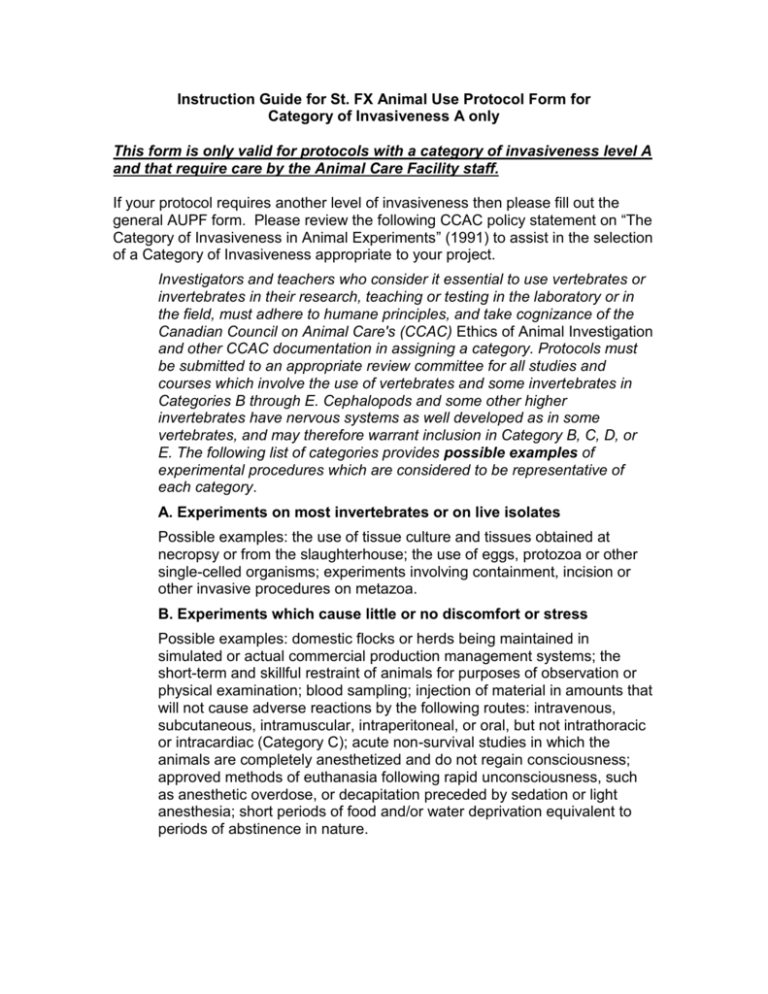
Instruction Guide for St. FX Animal Use Protocol Form for Category of Invasiveness A only This form is only valid for protocols with a category of invasiveness level A and that require care by the Animal Care Facility staff. If your protocol requires another level of invasiveness then please fill out the general AUPF form. Please review the following CCAC policy statement on “The Category of Invasiveness in Animal Experiments” (1991) to assist in the selection of a Category of Invasiveness appropriate to your project. Investigators and teachers who consider it essential to use vertebrates or invertebrates in their research, teaching or testing in the laboratory or in the field, must adhere to humane principles, and take cognizance of the Canadian Council on Animal Care's (CCAC) Ethics of Animal Investigation and other CCAC documentation in assigning a category. Protocols must be submitted to an appropriate review committee for all studies and courses which involve the use of vertebrates and some invertebrates in Categories B through E. Cephalopods and some other higher invertebrates have nervous systems as well developed as in some vertebrates, and may therefore warrant inclusion in Category B, C, D, or E. The following list of categories provides possible examples of experimental procedures which are considered to be representative of each category. A. Experiments on most invertebrates or on live isolates Possible examples: the use of tissue culture and tissues obtained at necropsy or from the slaughterhouse; the use of eggs, protozoa or other single-celled organisms; experiments involving containment, incision or other invasive procedures on metazoa. B. Experiments which cause little or no discomfort or stress Possible examples: domestic flocks or herds being maintained in simulated or actual commercial production management systems; the short-term and skillful restraint of animals for purposes of observation or physical examination; blood sampling; injection of material in amounts that will not cause adverse reactions by the following routes: intravenous, subcutaneous, intramuscular, intraperitoneal, or oral, but not intrathoracic or intracardiac (Category C); acute non-survival studies in which the animals are completely anesthetized and do not regain consciousness; approved methods of euthanasia following rapid unconsciousness, such as anesthetic overdose, or decapitation preceded by sedation or light anesthesia; short periods of food and/or water deprivation equivalent to periods of abstinence in nature. C. Experiments which cause minor stress or pain of short duration Possible examples: cannulation or catheterization of blood vessels or body cavities under anesthesia; minor surgical procedures under anesthesia, such as biopsies, laparoscopy; short periods of restraint beyond that for simple observation or examination, but consistent with minimal distress; short periods of food and/or water deprivation which exceed periods of abstinence in nature; behavioural experiments on conscious animals that involve short-term, stressful restraint; exposure to non-lethal levels of drugs or chemicals. Such procedures should not cause significant changes in the animal's appearance, in physiological parameters such as respiratory or cardiac rate, or fecal or urinary output, or in social responses. Note: During or after Category C studies, animals must not show selfmutilation, anorexia, dehydration, hyperactivity, increased recumbency or dormancy, increased vocalization, aggressive-defensive behaviour or demonstrate social withdrawal and self-isolation. D. Experiments which cause moderate to severe distress or discomfort Possible examples: major surgical procedures conducted under general anesthesia, with subsequent recovery; prolonged (several hours or more) periods of physical restraint; induction of behavioural stresses such as maternal deprivation, aggression, predator-prey interactions; procedures which cause severe, persistent or irreversible disruption of sensorimotor organization; the use of Freund's Complete Adjuvant (FCA) (see CCAC Guidelines on Acceptable Immunological Procedures). Other examples include induction of anatomical and physiological abnormalities that will result in pain or distress; the exposure of an animal to noxious stimuli from which escape is impossible; the production of radiation sickness; exposure to drugs or chemicals at levels that impair physiological systems. Note: Procedures used in Category D studies should not cause prolonged or severe clinical distress as may be exhibited by a wide range of clinical signs, such as marked abnormalities in behavioural patterns or attitudes, the absence of grooming, dehydration, abnormal vocalization, prolonged anorexia, circulatory collapse, extreme lethargy or disinclination to move, and clinical signs of severe or advanced local or systemic infection, etc. E. Procedures which cause severe pain near, at, or above the pain tolerance threshold of unanesthetized conscious animals This Category of Invasiveness is not necessarily confined to surgical procedures, but may include exposure to noxious stimuli or agents whose effects are unknown; exposure to drugs or chemicals at levels that (may) markedly impair physiological systems and which cause death, severe pain, or extreme distress; completely new biomedical experiments which have a high degree of invasiveness; behavioural studies about which the effects of the degree of distress are not known; use of muscle relaxants or paralytic drugs without anesthetics; burn or trauma infliction on unanesthetized animals; a euthanasia method not approved by the CCAC; any procedures (e.g., the injection of noxious agents or the induction of severe stress or shock) that will result in pain which approaches the pain tolerance threshold and cannot be relieved by analgesia (e.g., when toxicity testing and experimentally-induced infectious disease studies have death as the endpoint). Revised February 1991 This document is intended to provide more information to animal users on how to properly fill out the animal use protocol forms (AUPF). The document also contains additional relevant information from CCAC guidelines and policy statements to assist the animal user in understanding the current requirements of the St. FX Animal Care Committee (ACC). Quick hints for each field can be obtained within the AUPF by clicking on the field and looking at the help message in the status bar. General guidelines: The AUPF must be reviewed by all participating investigators (professors, instructors, technicians, students, etc.) prior to electronic submission to the manager of animal care. Signatures and are not required at the time of protocol submission, but rather will be obtained by the ACF manager as part of the protocol activation process. There are no submission deadlines for Category A protocols. Any person that will require space in the animal care facility should speak with Anne Louise MacDonald, the manager of animal care (x2126), prior to protocol submission. I. BASIC INFORMATION Principle Investigator: Enter the name of the lead investigator (research) or professor (teaching). Date: Enter the date of submission of this animal use protocol form to the ACC. Project Title: Enter a short but descriptive title for this project. If this is a research protocol then the project title should be the same as the title on your research grant/contract. It is necessary that we have this title correct to ensure we match up your animal care protocol approval with your grant, a process that is needed for release of grant money from the Business Office. Research/Teaching Checkbox: Check only one of these two boxes. Check the research box if this project is primarily a research project and NOT associated with a specific course or courses. Check the teaching box if this project is primarily a research project and IS associated with a specific course or courses. Arrival Date: This is the date you would like the animals to arrive at St.FX. If starting your project at a later date, indicate the date that you would like the protocol to be activated. Protocol activation date is connected with the release of your grant money from the Business Office. Usage Date: Date animals are required for experimentation or manipulations. Project End Date: Indicate the desired end date for this project. This date can be up to 1 year from the submission. Choosing an earlier date could affect fund availability. Grant/Course Account #: This information is necessary to release your funds from the Business Office and to make purchases of animals or animal supplies. All purchases will be approved by the PI prior to placement of purchase order by animal care. Course Number: This is required for all teaching protocols. Please list the course numbers (i.e. BIOL 304, PYSC 430, etc.) all courses that will utilize this protocol. Course Name: This is required for all teaching protocols. Please list the abbreviated course name (i.e. Intro Cell, Biodiversity) for all courses to be covered by this protocol. Emergency and After-Hour Contacts Enter the contact information for two personnel associated with the project that have the authority to make decisions on animal care and use. The principle investigator (PI) must be listed as an emergency contact. Be sure to include the following contact information: a building and room number that the emergency contact can be found during regular business hours, a week-day daytime contact number, and an after-hours contact number. II. INVESTIGATOR TRAINING & EXPERIENCE Personnel: List names of all personnel associated with this project, along with their departmental affiliation, their title or role in the project (professor, technician, student, etc.), whether or not they have completed the St.FX animal user training course (or equivalent), and the date the St.FX animal user training course (or equivalent) was completed. Contact the manager of animal care if there are any questions regarding animal user training. Training and Experience: Outline the relevant expertise and qualifications possessed by each project member prior to the start of the project. Outline a training program and supervision plan for the project members that lack expertise in animal handling or experimental procedures involving animals (i.e. how are you going to make inexperienced personnel experienced without jeopardizing animal health and well-being). Where ever applicable refer to ACC approved Standard Operating Procedures (SOP) for training and supervision. III. PROJECT OVERVIEW: Lay Summary: Using plain language summarize the entire project. This summary should be written like an abstract or research proposal executive summary giving some relevant background information, a brief but detailed description of the methods using live animals, and the anticipated outcomes. Biological or biohazardous agents: If you will be using biological/biohazardous agents in conjunction with live animals check Y, otherwise check N. Approved/Approval Date: If you checked N to the use of biological or biohazardous agents then leave these fields blank, otherwise you are required to have St.FX approval for the use of these agents. If you have that approval check the approved box and enter the date you received that approval. Radioisotopes or radioactive agents: If you will be using radioisotipes/radioactive agents in conjunction with live animals check Y, otherwise check N. Approved/Approval Date: If you checked N to the use of radioisotopes or radioactive agents then leave these fields blank, otherwise you are required to have St.FX approval for the use of these agents. If you have that approval check the approved box and enter the date you received that approval. Restricted agents: A controlled or restricted agent is any chemical or drug that requires either institutional or an external bodies approval for possession and use. If you will be using any of these controlled or restricted agents in conjunction with live animals check Y, otherwise check N. Approved/Approval Date: If you checked N to the use of controlled or restricted agents then leave these fields blank, otherwise you are required to have approval for the use of these agents. If you have that approval check the approved box and enter the date you received that approval. Treatments/Agents: List the name of all treatments and agents that will be used in conjunction with live animals. You should also indicate the species or taxonomic group that will be receiving the treatment/agent, the purpose of the treatment/agent (i.e. simulates stroke conditions), the dosage, concentration, and method and duration of exposure. Health and Safety Risks: If there is any potential health and safety risk associated with this protocol check Y, otherwise check N. A health and safety risk could be to project personnel, animal care staff or other animals in animal care (i.e. a rat bite). Disease Transmission Risks: If there is any potential risk of disease transmission associated with your protocol check Y, otherwise check N. Potential risks of disease transmission could be from your experimental animals to humans (zoonoses) or other animals in animal care or a sensitivity of your animals to disease transmission from other animals in animal care (immunecompromised animals). If you checked Y to either of the above risks, then indicate the nature of these potential risks (a rate bite) and what will be done to prevent their occurrence (refer to training and safe handling SOPs). You should also outline the contingency plans for the occurrence of these risks (refer to rat bite SOPs). Refer to ACC approved SOPs wherever appropriate. If you check N to both of the above risks, then please write n/a in these fields. IV. FATE OF ANIMALS Euthanasia methods: Post-experimentation all experimental animals are to be euthanized unless they are to be held for a specific purpose. For each species or taxonomic group required by this protocol indicate its fate post experimentation in the post-experimental fate field. Acceptable fates are euthanasia or held for a specific purpose. If animals are to be euthanized the method of euthanasia must be given in the Euthanasia method field. Consult with Animal Care or the CCAC website for a list of acceptable methods of euthanasia. If animals are to be held for a specific purpose then that purpose must be defined in the post-experimental fate field and the timeframe the animals will be held must be defined in the Timeframe for holding field. V. ANIMAL CARE REQUIREMENTS AND PROCUREMENT Animal holding space allocation: Space allocations within the animal care facility are done on a first come, first served basis. Species Information: For each species or taxonomic group required in this protocol please provide an appropriate name (ex. native cold water sea urchins), the desired source of procurement (put 1 for wild-caught, 2 for a ordering from a biological supply house, or 3 for in-house breeding), and the estimated number of individuals required for use in this protocol in the year this protocol will be active. For each species required to be purchased from a biological supply house (source code 2) list the scientific name of that species and a preferred supplier. Contact animal care for lists of reputable suppliers that have been used in the past. Do not list species required for this protocol that are not to be purchased from a biological supply house (source codes 1 or 3) Requirements for experimentation or animal care and housing: Indicate whether or not animal care staff are required to maintain the animals. If animal care staff are required to maintain animals then outline the holding requirements (i.e. 10ºC sea water, altered light cycle) that you may have for animal care staff as part of this protocol. Wherever appropriate refer to ACC approved SOPs. If you are unaware of the facilities’ capabilities or the standard housing and husbandry procedures then please speak with Anne Louise MacDonald prior to submitting this protocol.
